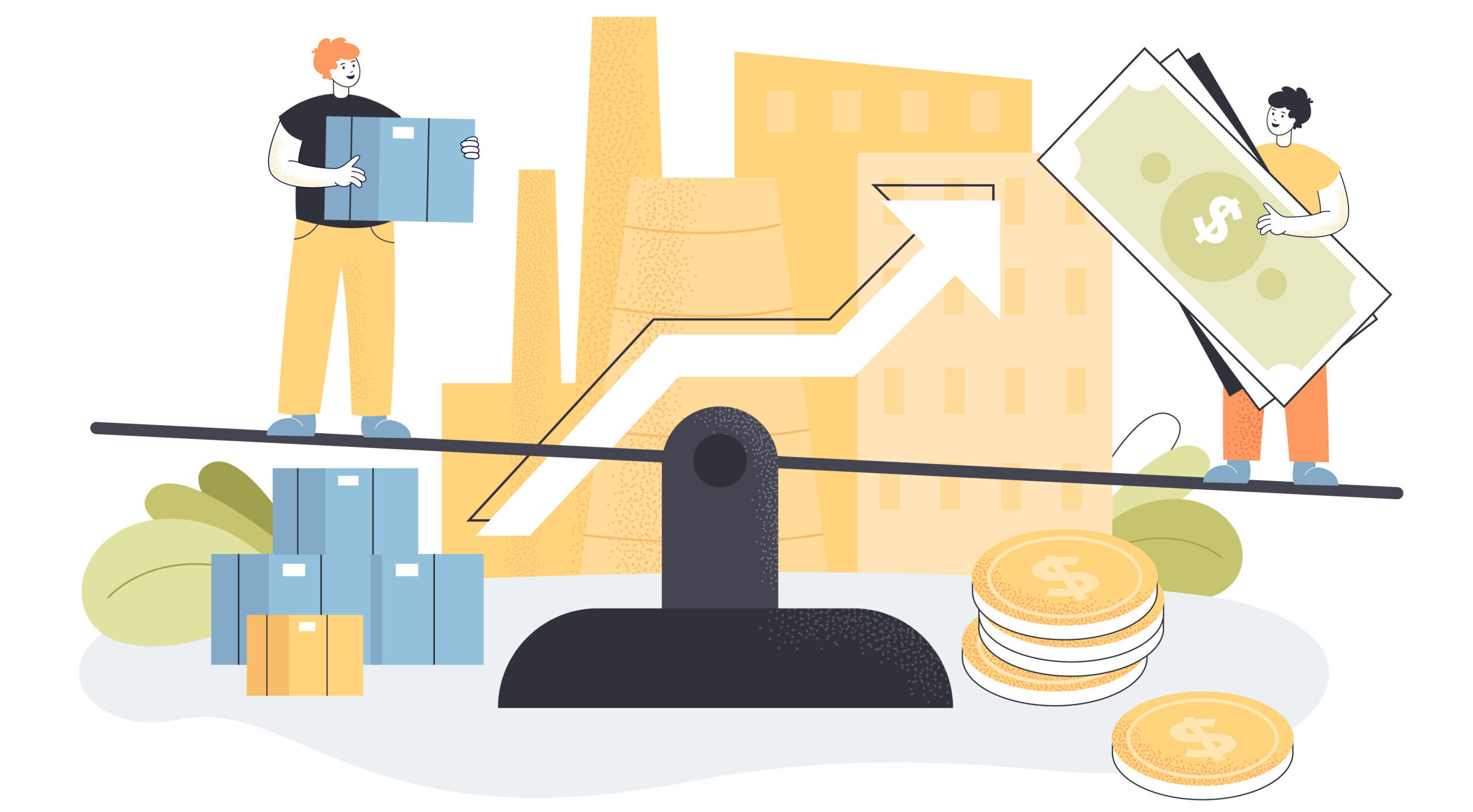How to Improve Your Financial Situation During Inflation
For more than two years, US citizens have been eagerly awaiting statistics on the level of inflation in the country. Business companies, banks, the Federal Reserve, and ordinary citizens thoroughly analyze this indicator. These statistics work like a thermometer, showing the prospects for economic recovery. It also serves as a signal of whether the key interest rate set by the US Federal Reserve will continue to rise.
The end of 2023 somewhat cooled the tune of optimists, who were confident that the inflation rate had begun to decline steadily. December indicators showed some increase in the inflation rate. This means that both the government and citizens should not relax but choose those strategies that will allow them to go through this period safely. Find out how you can support and even improve your family’s well-being during difficult times. This will help you live a prosperous life, regardless of any indicators.
General Context of Inflation in 2021-2023
Inflation is not just numbers in statistical reports but also the rise in prices that consumers see every day:
- Higher costs for housing;
- Inability to regularly dine out;
- Rising prices for gasoline and car insurance;
- Growth of grocery prices and much more.
Trying to somehow cope with the challenges of inflation, many people are forced to look for additional work, take out loans, sell real estate, etc. When possible, they prefer to take payday loans with no credit check, since the credit history of many Americans is deteriorating amid economic crises. Of course, in such a situation, many blame the US government, thinking that its erroneous actions are the main cause of inflation. However, this problem is worldwide, and that is why it takes so much time to overcome it.
Causes of Inflation 2021-2023
The inflation situation in the United States in the pre-pandemic period was relatively stable. The rates fluctuated around 2%, which is considered acceptable by the Federal Reserve. However, from mid-2021, inflation began to rise all over the world due to the disruption of economic ties caused by the pandemic, as well as the measures that governments and central banks took to save the situation.
- The US also suffered from this situation, and by the end of 2021, the inflation rate reached 4.7%.
- The situation was further worsened by the war in Ukraine. Prices for food, oil, gas, fertilizer, and other resources and goods have skyrocketed. As a result, by June 2022, the inflation rate in the United States reached a frightening 9.1%.
- Government actions and a gradual increase in the key interest rate by the Federal Reserve prevented this situation from continuing to worsen. After this peak, the inflation rate began to decline steadily. However, the dream that it will soon return to pre-crisis conditions is still distant in time.
Here are some key contributors to inflation between 2021 and 2023 Globally:
- Pandemic-Induced Supply Chain Disruptions: The COVID-19 pandemic disrupted global supply chains, causing shortages of raw materials, components, and finished goods. Supply chain disruptions, including factory closures, transportation bottlenecks, and labor shortages, constrained the availability of goods and services, leading to upward pressure on prices due to increased demand relative to supply.
- Fiscal Stimulus and Government Spending: To mitigate the economic impact of the pandemic, governments around the world implemented massive fiscal stimulus packages, including direct payments to individuals, expanded unemployment benefits, and infrastructure spending. While these measures helped support household incomes and stabilize economies, they also injected significant amounts of money into circulation, leading to increased aggregate demand and inflationary pressures.
- Monetary Policy Responses: Central banks responded to the economic challenges posed by the pandemic by implementing accommodative monetary policies, including near-zero interest rates and large-scale asset purchase programs (quantitative easing). These measures were aimed at stimulating borrowing, investment, and consumer spending. However, they also increased the money supply, which, combined with fiscal stimulus, contributed to inflationary pressures.
- Commodity Price Increases: Prices of key commodities, including oil, metals, and agricultural products, experienced significant increases between 2021 and 2023. Supply disruptions, geopolitical tensions, and strong demand from recovering economies drove up commodity prices, leading to higher production costs for businesses and upward pressure on consumer prices.
- Labor Market Dynamics: Labor shortages and wage increases were observed in various sectors, particularly in industries heavily affected by the pandemic, such as hospitality, retail, and healthcare. Employers faced challenges in hiring and retaining workers, leading to wage pressures as businesses competed for labor. Higher wages, when passed on to consumers in the form of increased prices for goods and services, contribute to inflationary trends.
- Global Economic Rebound: As economies rebounded from the pandemic-induced slowdown, consumer spending and business investment picked up pace. The rapid recovery, coupled with pent-up demand and increased consumer confidence, led to stronger economic activity, which, in turn, contributed to inflationary pressures as demand outpaced supply in certain sectors.
- Supply Bottlenecks and Shipping Delays: Persistent supply chain disruptions, exacerbated by factors such as container shortages, port congestions, and logistics challenges, led to delays in the delivery of goods and increased transportation costs. These supply bottlenecks constrained the availability of goods, resulting in higher prices for imported products and contributing to inflationary pressures.
- Exchange Rate Movements: Currency depreciation or fluctuations in exchange rates can influence inflation by affecting the prices of imported goods and services. Depreciation of local currencies relative to major trading partners can lead to higher import costs, which are passed on to consumers in the form of increased prices, contributing to inflationary pressures.
- Geopolitical Tensions and Conflicts: Geopolitical tensions and conflicts, such as trade disputes, sanctions, and geopolitical unrest, can disrupt global trade flows, increase production costs, and create uncertainty in financial markets. These factors can contribute to supply disruptions, higher commodity prices, and increased inflationary expectations.
- Inflation Expectations: Expectations of future inflation play a significant role in shaping actual inflation outcomes. If businesses and consumers anticipate higher inflation in the future, they may adjust their behavior accordingly, leading to self-fulfilling prophecies. Central banks closely monitor inflation expectations and employ policy measures to anchor them to their inflation targets.
The inflation experienced between 2021 and 2023 was influenced by a combination of factors, including pandemic-induced supply chain disruptions, fiscal and monetary policy responses, commodity price increases, labor market dynamics, global economic rebound, supply bottlenecks, exchange rate movements, geopolitical tensions, and inflation expectations. These factors interacted in complex ways, contributing to varying degrees of inflationary pressures across different economies during the period.
What Is the Inflation Situation in the USA Today?
During the first half of 2023, the inflation rate steadily decreased:
- 2023 began at a level of 6.4%, and by June, inflation had fallen by more than half, reaching 3%.
- However, after this, inflation began to rise again, and by August and September, a new peak of 3.7% was reached.
- After that, the decline began again with a new low of 3.1% in November.
- However, this trend reversed, and America ended the year with a slight increase in December to 3.4%.
As a result, forecasts regarding the rapid restoration of the situation to pre-pandemic levels have not yet come true, and the Fed doesn’t promise to lower the key interest rate soon.
Effective Ways to Combat Inflation in Personal Finance
It is necessary to take a comprehensive approach to budgeting personal finances to manage the increase in prices for goods and services. Combating inflation in personal finance is crucial for maintaining the purchasing power of your money over time. Inflation refers to the general increase in prices of goods and services, which erodes the value of money. To effectively combat inflation in personal finance, you need to employ strategies that either mitigate its impact or allow your assets to outpace inflation. Here are some effective ways to combat inflation:
- Invest in Inflation-Protected Securities: Treasury Inflation-Protected Securities (TIPS) are bonds issued by the U.S. Treasury that adjust their principal value based on changes in the Consumer Price Index (CPI), which measures inflation. Investing in TIPS can provide a hedge against inflation as the value of the bond adjusts upwards with inflation, ensuring that your investment keeps pace with the rising cost of living.
- Diversify Your Investment Portfolio: Diversification is key to managing inflation risk in personal finance. Spread your investments across different asset classes such as stocks, bonds, real estate, and commodities. Stocks, especially those of companies with strong pricing power and the ability to pass on increased costs to consumers, can provide a hedge against inflation over the long term.
- Invest in Real Assets: Real assets like real estate, commodities (such as gold and oil), and infrastructure investments tend to perform well during periods of inflation. These assets have intrinsic value and can act as a hedge against inflation by preserving wealth in real terms.
- Consider Equity Investments: Historically, equities have outpaced inflation over the long term. Investing in a diversified portfolio of high-quality stocks or equity mutual funds can help your investments grow faster than inflation. Look for companies with strong fundamentals, pricing power, and the ability to maintain or increase dividends over time.
- Focus on Income-Generating Investments: Invest in assets that generate a steady stream of income, such as dividend-paying stocks, bonds, rental real estate, and dividend-focused mutual funds or exchange-traded funds (ETFs). Regular income streams can help offset the impact of inflation by providing a growing source of cash flow that keeps pace with rising prices.
- Review and Adjust Your Savings and Investment Strategy Regularly: Inflation rates can fluctuate over time, so it’s essential to periodically review and adjust your savings and investment strategy to ensure that it remains aligned with your financial goals and risk tolerance. Rebalancing your portfolio and reallocating assets based on changing economic conditions can help you stay ahead of inflation.
- Avoid Keeping Too Much Cash: While it’s important to have liquid cash for emergencies and short-term needs, holding excessive cash can erode your purchasing power over time, especially during periods of high inflation. Consider investing surplus cash in assets that have the potential to provide higher returns than cash over the long term.
- Invest in Education and Skills Development: Investing in yourself through education, skills development, and professional certifications can enhance your earning potential and help you stay ahead of inflation. Continuous learning and skill upgrades increase your value in the job market, allowing you to command higher salaries or pursue better career opportunities.
- Reduce Debt and Interest Payments: High-interest debt can exacerbate the impact of inflation on your finances. Focus on paying off high-interest debt such as credit card debt and personal loans as quickly as possible to reduce interest payments and free up more money for savings and investments.
- Monitor Inflation Expectations: Keep an eye on inflation expectations and economic indicators that signal changes in inflation trends. Understanding how inflation expectations are evolving can help you adjust your financial strategy accordingly and make informed decisions about savings, investments, and expenses.
- Analyze your expenses and highlight the necessary ones that cannot be avoided. For example, the rent for your home has become more expensive, but for some reason, you cannot currently move to a cheaper apartment.
- Identify expenses that can be avoided or significantly reduced.
- Consider cheaper options for each expense item. For example, if you didn’t pay attention to sales before, try to cover your needs with goods purchased at sales.
- Plan your trips. Earlier purchase or booking of plane tickets, hotels, etc. will allow you to save significantly. Also, choose closer travel routes. The situation of inflation is a great opportunity to discover many wonderful places in your area.
- Try to find friends, neighbors, or people nearby with whom you can share long trips. Perhaps one of them drives in the same direction as you every morning. By sharing the costs of fueling and servicing your car, you can also save a lot of money against the backdrop of rising energy prices.
- Learn some skills that will allow you to save on paying for various services. For example, if you previously hired a gardener to take care of your garden, try doing the gardener’s tasks yourself. Perhaps, thanks to this, you will discover a new hobby that will delight you even after inflation subsides.
In summary, combating inflation in personal finance requires a proactive approach that includes investing in inflation-protected securities, diversifying your investment portfolio, focusing on income-generating assets, and periodically reviewing and adjusting your financial strategy to stay ahead of inflationary pressures. By implementing these strategies, you can better protect your purchasing power and achieve your long-term financial goals despite inflationary challenges.
See inflation not as a tragedy but as a challenge that opens up new opportunities. And then the statistical indicators will seem not so important. For any indicator, you will have an effective strategy that will allow you to maintain financial balance in any situation.


















